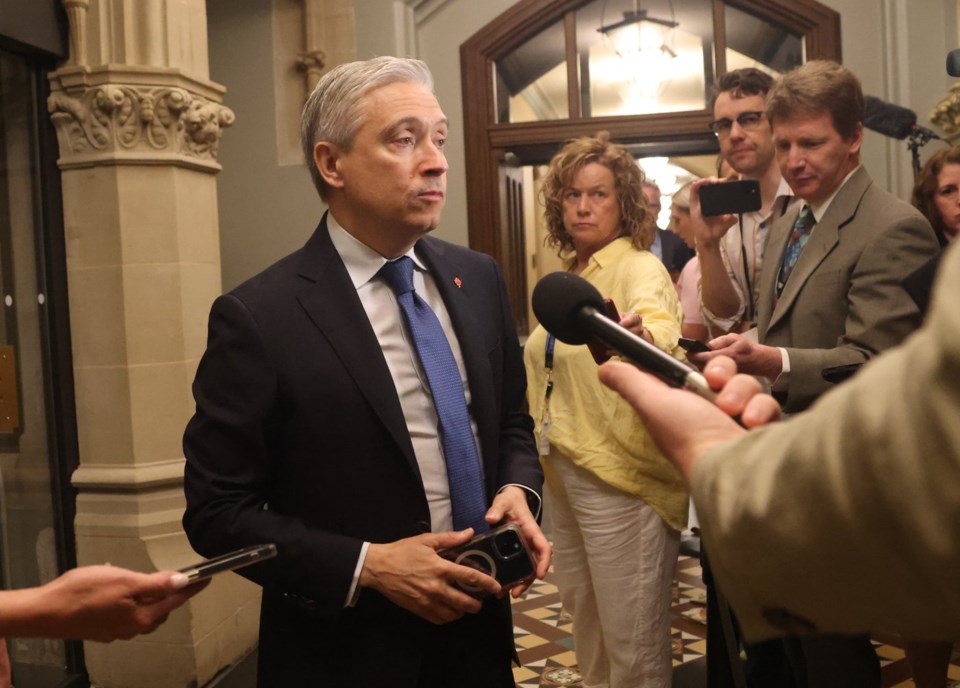OTTAWA — A new report by the Canadian Centre for Policy Alternatives says the federal public service could shed almost 60,000 jobs over the next four years as Ottawa looks to cut costs.
Earlier this month, Finance Minister François-Philippe Champagne sent letters to multiple ministers asking them to identify cuts to program spending at their departments of 15 per cent by 2028-29.
The report, written by Canadian Centre for Policy Alternatives senior economist David Macdonald, says the federal public service could lose up to 57,000 employees by 2028.
The report predicts that tens of thousands of jobs will be cut at the Canada Revenue Agency, Employment and Social Development and Immigration, Refugees and Citizenship Canada — three federal bodies that have already seen a drop in employees in recent months.
The report says the cities of Ottawa and Gatineau will likely "bear the brunt" of the cuts because almost half of the job losses will be in the National Capital Region.
The report predicts service impacts will be felt across the country and the cuts will mean longer wait times, more errors and "fewer people to fix those errors."
The report says the government is asking departments to find savings to help cover major military spending increases and tax cuts.
Barb Couperus, spokesperson for the Treasury Board of Canada Secretariat, confirmed a lower savings target of two per cent has been set for the Department of National Defence, the Canada Border Services Agency and the RCMP.
Couperus said ministers have been tasked with reviewing spending across their portfolios to identify programs that are "meeting their objectives, are core to the federal mandate and complement — rather than duplicate — services offered by other federal departments or levels of government."
"This review reflects a return to core responsibilities, with a clear focus on fiscal discipline, quality service delivery, and long-term economic growth," she said.
Couperus said "agents of Parliament," the Courts Administration Service and the Office of the Registrar of the Supreme Court of Canada are exempt from the review process "to preserve their independence."
Agents of Parliament are considered independent of government and include the auditor general, the chief electoral officer and the parliamentary budget officer.
She said only organizations under a minister’s portfolio are included in the review — meaning that independent organizations like the House of Commons and the Senate are not included.
"Statutory transfer payments to provinces, territories and individuals will be maintained, but most other government spending will be included in the review," she said, adding that Crown corporations are also subject to the exercise.
Macdonald's report suggests ministers have some flexibility in choosing where the cuts will land.
"For instance, a department may propose to cut fewer than 15 per cent of their staff, but that means other budget items will have to be cut by more than 15 per cent to make up the difference," it says.
In an earlier report, Macdonald said there could also be cuts to areas such as transfers to First Nations governments, supports for veterans and newcomers, international aid and research.
Prime Minister Mark Carney campaigned in the spring election on a promise to "cap" but not cut public service employment. He also promised to launch a "comprehensive review" of government spending to increase productivity.
In an email, Macdonald said Carney's campaign promise not to cut the public service "never made sense."
He said operational expenditures are already "capped" at about $130 billion a year and that "it always had to be cuts."
"In the campaign, they were targeting staffing (and) other operational spending," Macdonald said in the email.
"But this expanded substantially to include departmental transfers in July, probably to pay for the massive new defence spending that happened just weeks after the election (and weren't in the platform or certainly not that quickly)."
Macdonald said the government likely will offer buyouts to older employees to encourage more retirements. He also said cuts will likely involve "the end of all term and casual employment."
"These are going to tend to be younger workers who aren't yet indeterminate," he said. "Then it will be indeterminates that will go through workforce adjustment that may end in layoffs."
Nathan Prier, president of the Canadian Association of Professional Employees, said the union is very concerned by what it calls the "broken promise" not to cut the federal public service.
He said departments are now being told to find savings that could amount to a "drastic reduction in the quality of public services that Canadians rely on."
"Canadians were hoping with their choice last election that as a country we’d stand up to threats from (U.S. President Donald Trump), make strategic investments in our economy and diversify our trading partners, and to do that we need a strong federal public service," Prier said.
The Carney government's cuts follow previous cuts introduced in Budget 2023 under the "refocusing government spending" initiative. The report said those cuts are already affecting staffing levels and that their "savings" will hit their peak impact in 2026-27.
The federal public service shrunk by almost 10,000 people last year, with the number of public servants employed by the federal government falling from 367,772 to 357,965.
This report by The Canadian Press was first published July 24, 2025.
Catherine Morrison, The Canadian Press



